SHORT SYNOPSIS
Is it possible to fly like a bird?
What makes you dream is to be in the middle of migratory birds in flight, and to migrate with them. To become totally a bird such is the purpose of our film with virtual reality and a total immersion in the Kingdom of the birds, in company of Christian Moullec.
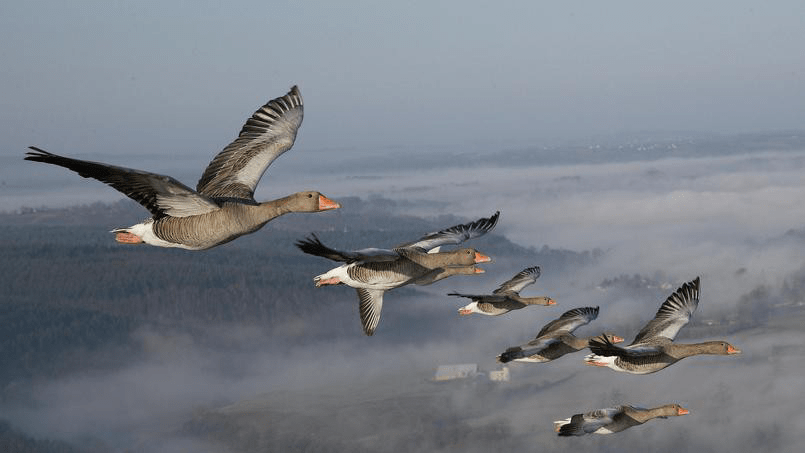
Sometimes you can see a flock of migratory birds passing in the sky, accompanied by a white microlight. The man in the sky is called Christian Moullec. He was the first to initiate birds to follow him behind his flying machine, in order to teach them a new migration route, less dangerous for their survival. This is how he allowed 30 young Scandinavian Lesser White-fronted Geese to migrate with him to Germany, rather than to the Black Sea coast where hunters were decimating the species.
This story is a journey to the land of migratory birds, close to the land of men, among the sounds of the farm with its many aviaries housing greylag geese, red-breasted geese, Manchurian cranes, mallards, damselflies, crowned cranes and whooper swans.
Christian Moullec follows real migrations in which he slips. And his encounters with “birdmen” on the ground, who are ornithologists, protection associations, and bird enthusiasts, allow him to deepen his knowledge and relationships with these incredible migrants.
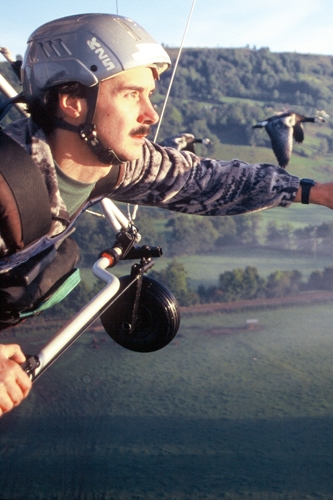
France, crossroads of migratory currents… Thanks to its strategic geographical location, to the diversity of its natural environments and to the air currents that cross it (Christian is a meteorologist), France is an essential stopover for tens of millions of birds and bats flying over or crossing our territory from February to June to reach their nesting area, or from August to November to reach their wintering grounds.
If we are lucky enough to be able to observe one of the most beautiful spectacles of nature twice a year, for Christian, it is also incumbent upon us to take our responsibilities to protect these migratory species, symbols of a common transnational natural heritage: the survival of millions of birds depends on the conditions of passage and reception that we reserve for them.
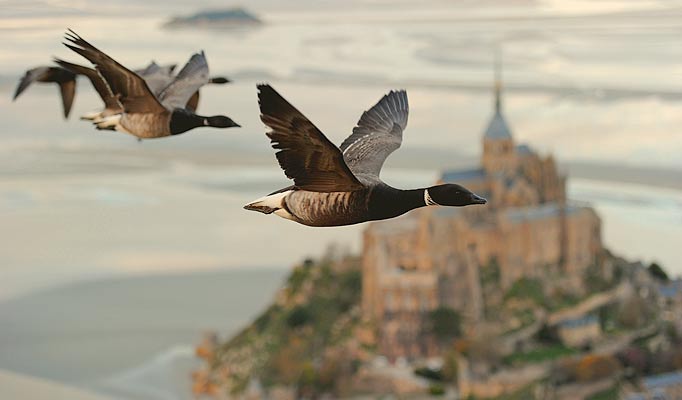
We leave for 3 great French regions, places of migration par excellence like Brittany, the Landes and the Camargue. Christian will live in the middle of the most diverse species, meet scientists, amateur ornithologists, atypical characters…
In each of his regions, Christian participates in the experiments of these high-flying researchers. Christian studies with an ornithologist scientist how the legs of birds warm up in full flight, and serve as a radiator. For this we film with a thermal camera.
Another American scientist (thesis in the USA) explains to us the formation flight of birds and why birds fly at an angle. A scientist of the laboratory of Chizé studies the heartbeat of the birds in full flight.
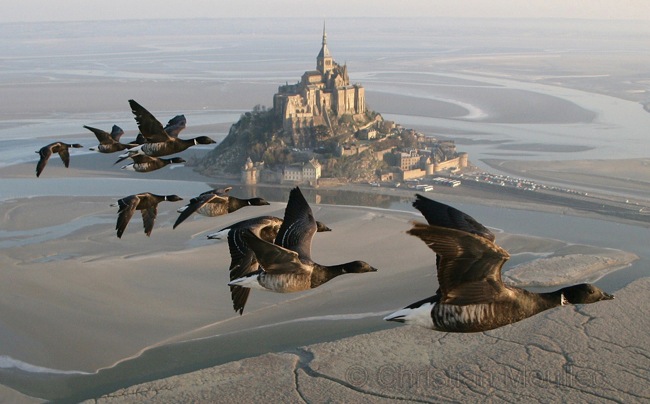
Christian Moullec is itinerant with his floating Ulm and his groups of migratory birds. In his itinerary, at each step, Christian Moullec meets the persons in charge of the sites, the reserves, the “madmen” of the associations of protections …. He flies over each site with his birds.
When he is not in the air, he is in his floating Ulm, at the water’s edge, in the middle of the birds. He goes to meet all sorts of bird species, some of which are mysterious on an ethological level. He is on the lookout with those they observe flying, then when he lands he observes the other birds floating. He is one with nature. His eyes read the Book of Wonders of the birds of the world.
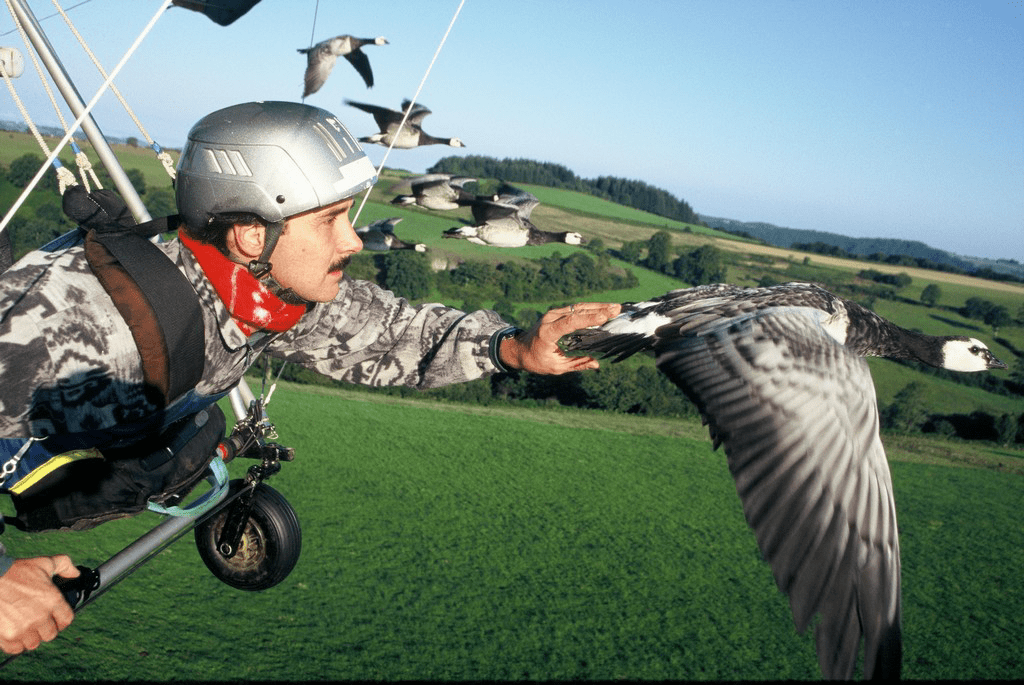
France is the crossroads of bird migrations… The air is a viewpoint of exceptional sites! It is however a perilous territory for the migrants!
The future of many species is uncertain. In France, the regression of natural spaces, wetlands, the decrease of insects, the development of aerial structures, light pollution, are all threats for migratory birds, which already face many natural hazards. Climate change affects the species by modifying the period of peak emergence of insects, before their return to the breeding sites. The actions to be taken are urgent.
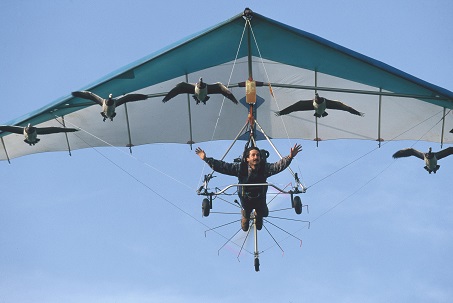
Christian is also at the heart of this concerted mobilization. Associations supported by independent ornithologists respond to these challenges for the protection of migrants. The Mission Migration is on the ground with Christian, fighting on all fronts, analyzing conservation issues, conducting exceptional protection actions and relying on the involvement of citizens. Migrators are also a human story!
Christian reveals the study of migrations with :
– Scientific studies
– Counting in the field
– Ringing programs
– Satellite tracking
– Radars
– Migrators and climate change
– Actions for the protection
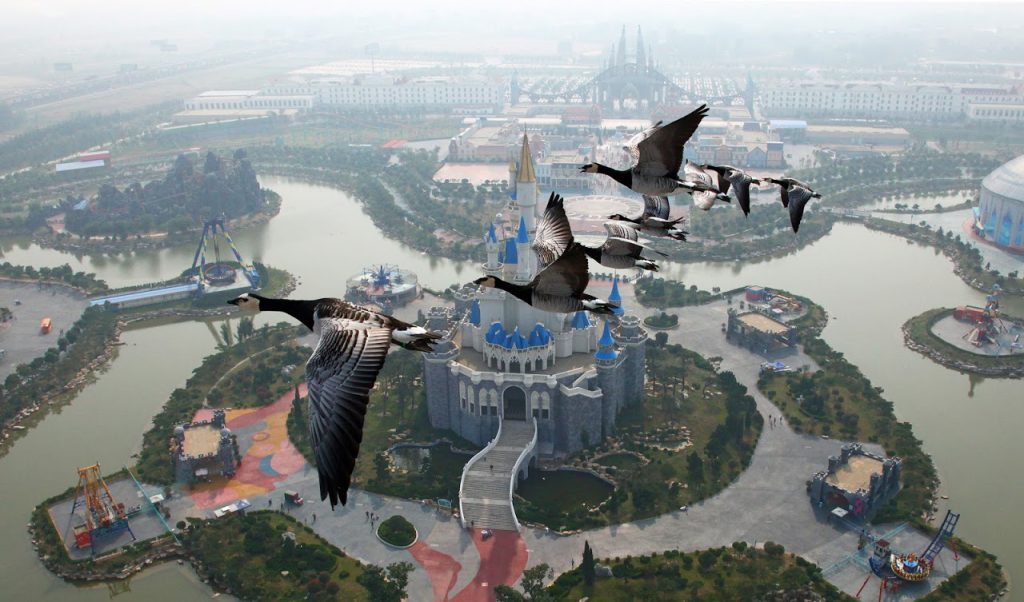
To live among birds, like a bird (a strange bird this Christian), to feel bird, to think bird, to drink and eat sometimes bird, to share their daily life and to be adoptive father of a swarm of birds, is a unique, original and extraordinary experience that Christian Mouillec has the immense pleasure to share with us so much his joy and his art of living are infectious. But the path of a migration is full of pitfalls!
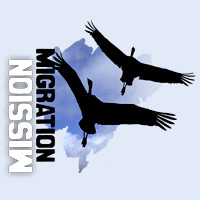

DEVELOPED SYNOPSIS
Twice a year, the sky of France is the scene of one of the most beautiful and mysterious natural spectacles involving tens of millions of birds… If migration has always fascinated Man, migratory species are forced to migrate to find food resources or to flee an unsuitable climate… Also, they are able to travel several thousand kilometers. It is thus a delicate moment. And yet, our human activities which are multiplying constitute additional threats. It is urgent to take the necessary measures to facilitate the migration of these travelling species which make us dream so much.
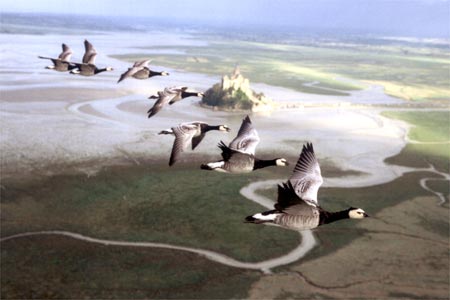
France is a crossroads for millions of migratory birds that cross our country and stop here. But Christian Moullec has been witnessing a decline of these great travelers for a few years. Human activities have upset their bearings and make their journey difficult. This documentary proposes to follow Christian Moullec, who has been studying and observing birds for over 40 years. On board his microlight, he imagined a crazy project to offer birds a chance to continue their pilgrimage over our heads: a “school of migration”. But not only!…
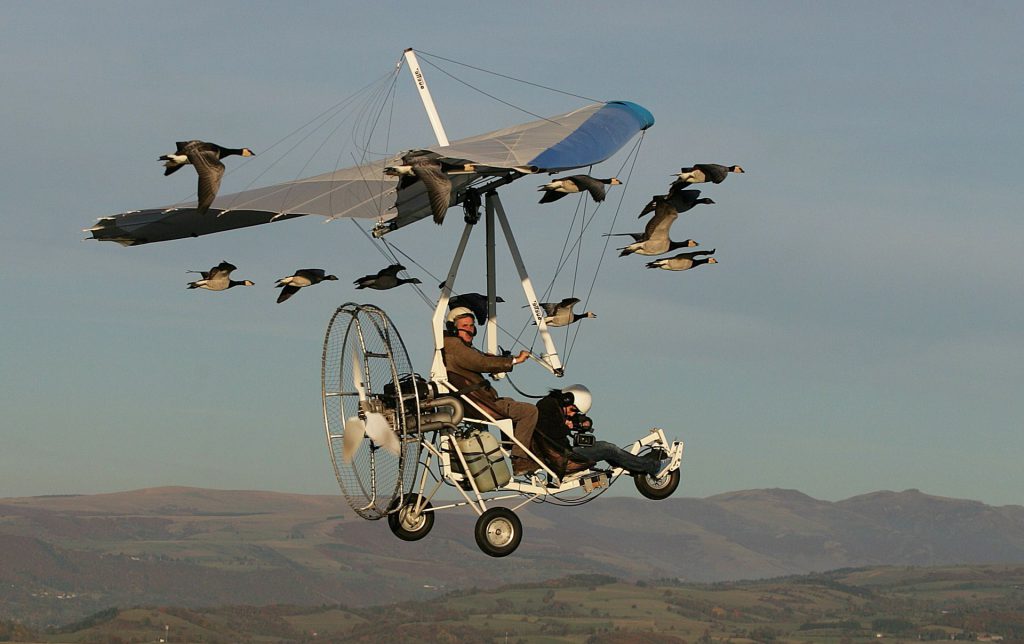
In our three most beautiful regions of France, we discover the path of a migration… full of pitfalls:
1 Light pollution. illuminated buildings and headlights are a new threat: they are traps for some nocturnal migrants who are attracted to these points of light and hit them head-on.
2 electrocutions and collisions. Medium and high voltage lines represent a risk of electrocution, as the electric poles are used as staging posts or resting places. This is the case for large-scale species (mainly raptors) that may come into contact with both phases simultaneously. It is difficult to quantify the number of victims.
3 wind turbines (offshore and onshore). Wind turbines have 3 main types of impacts on birds but also on bats: habitat loss, direct mortality and disturbance. They should therefore not be placed on migratory corridors.
4 Global warming. Climate change is disrupting migratory species. The most affected are those for which migration is triggered by a precise internal clock. Some of them are out of step with the peak of emergence of the insects they feed on, the consequences are dramatic with insufficient food for the young. The drought also accentuates the desertification in Africa, making the flight over these regions even longer and more difficult.
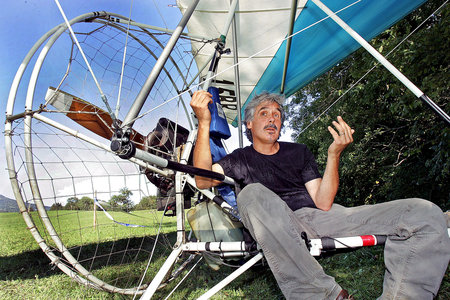
5 Hunting and poaching. Hunting dates are not always consistent with the protection due to migratory species. Even more serious is the poaching that takes place illegally on very important migration sites.
6 Deterioration of obligatory passages… While some species, such as passerines, have a broad migration front, other species use well-defined migration “corridors” in space. Specific places, such as coastal bangs or mountain passes, become transit zones where it is therefore important that human impact is as low as possible.
7 … and migratory stopovers. Deforestation, the drying up of wetlands, the use of pesticides and other pollution have a direct impact on migration. Preserved resting places are essential for the birds to regain their strength and accumulate energy reserves, which are indispensable for the continuation of their journey.
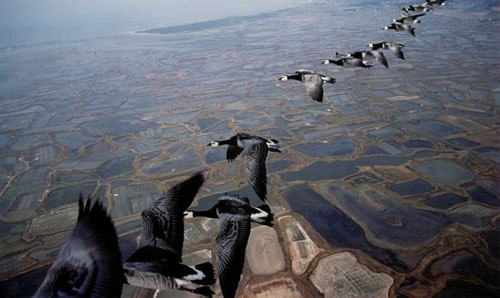
The solutions proposed by Christian and the associations including the LPO…
Today, the migratory birds face new threats which could be minimized or even avoided. It is urgent to act, and this is what Christian does with the various associations of protection of the migratory species: They are in action in :
– the maintenance of migratory stopover sites: preservation of wetlands, fight against deforestation, sensitization of farmers against the use of pesticides, acquisition of land, classification as a nature reserve…
– prevention of man-made risks: work in collaboration with the companies concerned before the installation of wind turbines and medium and high voltage lines to avoid their installation on migratory routes and position them in a relevant way in order to make the existing network less dangerous.
– the prevention of urbanization in certain areas…
– the respect of hunting dates, denounce poaching and all other violations of the law.
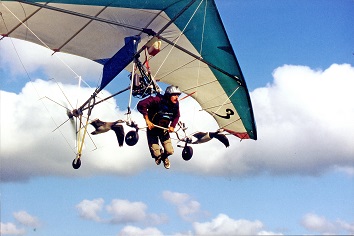
– improving knowledge
– acquire data: develop ornithological radar monitoring, conduct ringing and tagging operations, study and monitor migratory species by identifying and counting birds at strategic sites,
– exploit and analyze these data. Raising awareness and involving the general public
– to develop networked migration monitoring sites in France: Visionature, Mission Migration,
– recruit and retain new volunteer observers.
– animate workshops and outings (Eurobirdwatch…).
In these 3 French regions that are Brittany, the moors, the Camargue, with these migrations, Christian has the immense pleasure of sharing magical moments with birds.
BRITTANY
Christian Moullec, aboard his Ulam, embarked on a trip between Cantal and Brittany, with a dozen Brant. A relatively large group requiring constant attention. It is essential that the person on the ground observes permanently if an element of the group does not go astray. The ULM must imperatively evolve at the rhythm of the most difficult students.
At all times, Christian counts them. Some birds land anywhere, we must not lose sight of them in order to recover them as soon as possible to avoid predators like eagles.
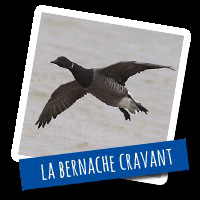
Christian Moullec returns, at first with his “flying children” (his birds that he breeds in the Cantal), in his original environment, Brittany where he lives, with what he holds most dear in the world: the Kingdom of birds along the coasts, in the salt marshes, on the edge of the Atlantic Ocean which has a very strong iodine scent…
He is in total immersion with the brant, then in other sites with the greylag geese or the grey cranes, which accompany him in his migratory journeys. He takes care of these 3 species which fly with him, like the apple of his eye. This creates a certain tension because he is not allowed to lose one of them!
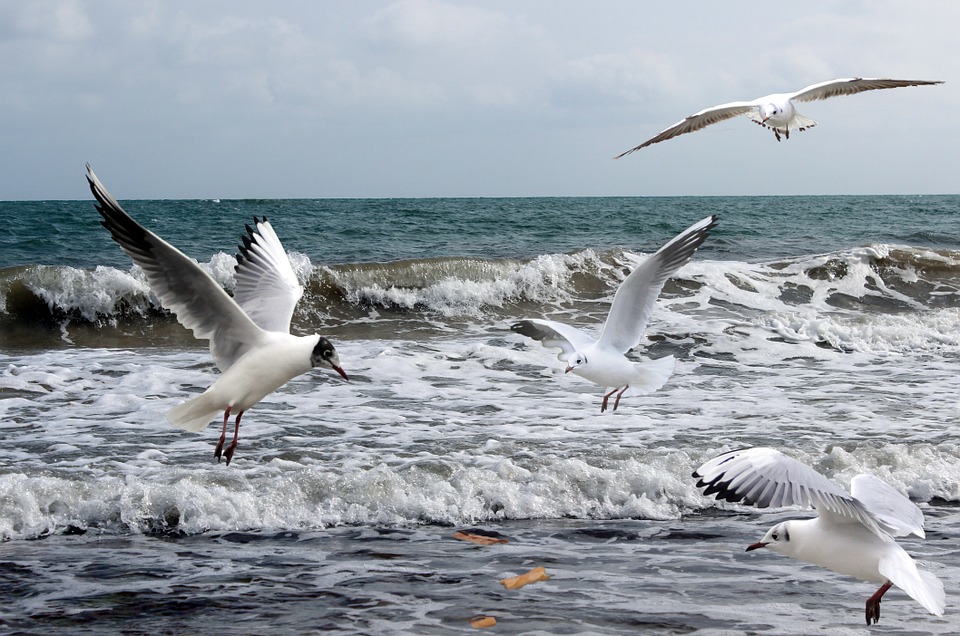
Christian, who has been observing the flight of birds for years, now has a unique point of view. In this new dimension he reaches, he goes from wonder to discovery. The vortex created by the tip of his moving wing acts a bit like a vacuum cleaner used by birds to save energy. They work together in the same way, with the bird in front pulling the bird just behind it partly in its wake.
In turn, they take turns leading the formation. He also found that the more skilful birds use the denser air mass against the leading edge of the wing to let themselves be carried along without any flapping of the wings, as if they were surfing on an invisible wave. According to the American scientist, NASA has estimated that by flying this way it is possible to save up to 20% of energy. It is conducting tests on F-18s.
A second scientist is studying the heartbeat of birds in flight.
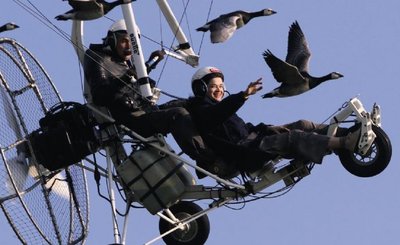
By their behavior in front of the multiple dangers of the flight, the birds initiate the pilot to prudence and teach him to be wary of the traps. Christian thus realizes that the birds do not like to fly in the barbules. “I felt when they flew that they are really anxious, I promise myself to avoid this kind of fear in the future.
Another evening, he takes off despite a threatening sky, acting with simple human reasoning, the birds absolutely do not want to gain altitude and hook his ultralight. Christian has to fly dangerously low in the trees.
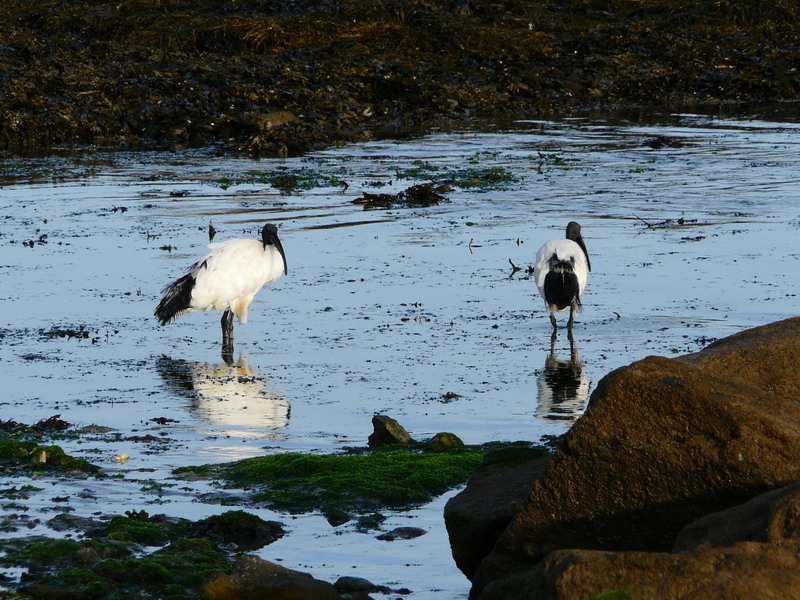
But in his journey, he sees many birds that are decimated by hunting. In this carnage, the hunters do damage as well as the food agriculture industries.
Christian has no tongue in cheek about their misdeeds, even though he has managed to make some of these hunters cry and convince them to hang up their guns.

Christian flies, at the time of the great migrations, with his Brant geese along the French coast, in Brittany. His birds mix with the migratory ones. Brant frequent mudflats in natural shelters, most often in flocks that can reach several hundred individuals.
Like a bird in the water, Christian lives among them in his Ulm, which serves as a privileged observation post. He evolves in these five privileged observation sites of the Brent Goose which are listed in France, in Finistère (the cove of Penfoulic at Cap-Coz in Fouesnant, the cove of Goulven; and in winter on the Côtes-d’Armor: at Saint-Jacut-de-la-Mer, at the mouth of the Trieux river but also at Kerpalud, next to the port of Paimpol, or in the Bay of Saint-Brieuc where they winter).

Christian photographs and films the breeding which takes place in June.
Brant nest in small colonies, often on islands.
The migration starts at the end of September.
In winter it is often associated with the whistling duck.
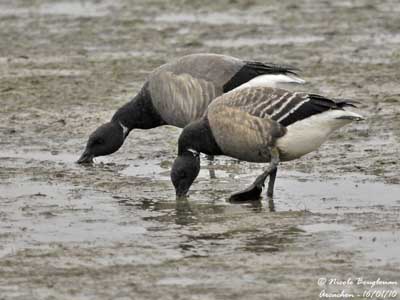
It is primarily a marine species that is rarely found in freshwater. On the wintering grounds, the Brant is a strict herbivore. Over the last few decades, geese have broadened their range of food resources by staying more pronounced on grazed meadows or winter cereals.
This would explain why, while many other species of seabirds or wetlands are declining, this species is locally increasing strongly. Depending on the year, France hosts nearly 50% of this population.
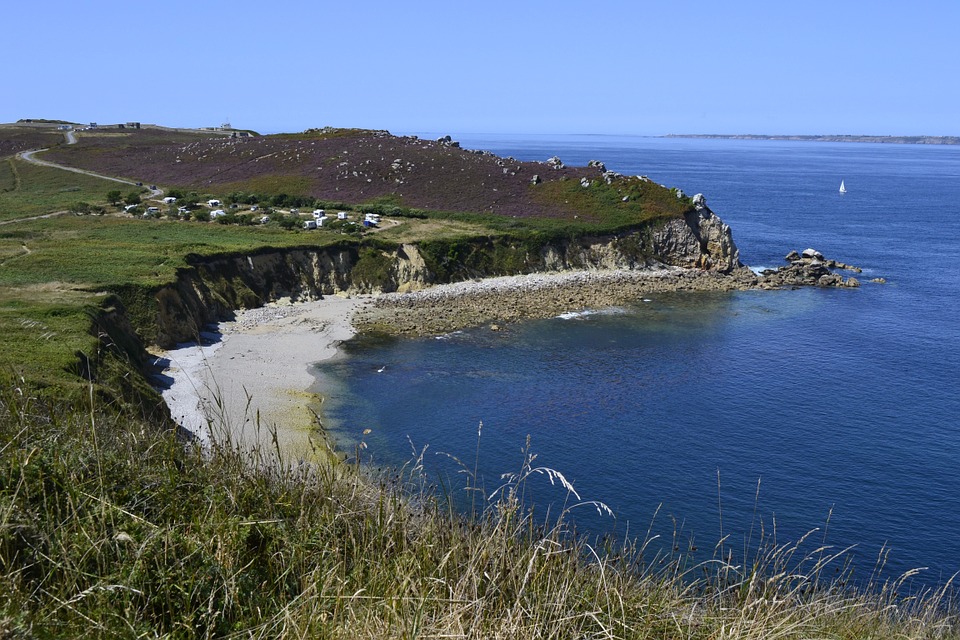
The Brent Goose benefits from a total protection on the French territory. It is therefore forbidden to destroy, mutilate, capture or remove it…
However, scientific studies on the Brent Goose do provide some certainty about the destruction of the meadows: these analyses are based on a comparison of the quantity of eelgrass consumed by herbivorous birds (geese, swans and whistling ducks) and the quantity produced by the meadows. There would be no incidence!
In Brittany, they want to reopen the hunting of brant, which risks to decimate the species. Now civilians can get close to the birds, which are not afraid of anything anymore, but if the hunting resumes, it’s over, people won’t be able to get close to them. Christian is against this hunt!

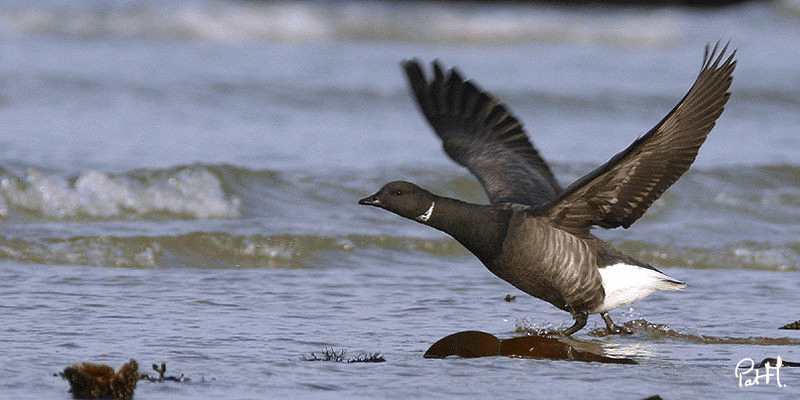
THE LANDES OF GASCONY
With his cranes, Christian Moullec is now flying over the Landes. He flies over Arjuzanx. A set of loud cries breaks the calm of the Landes sky. Above Christian’s head, in his Ulm, large birds in formation are migrating towards warmer territories.
No more doubt, winter is here, and with it the return of our Common Cranes. It is a unique opportunity to see such a phenomenon in the Landes to understand everything about this majestic bird! Up to 40,000 cranes stay here each winter, making the Landes one of the most important wintering areas in Europe.
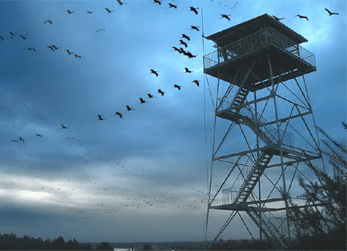
From November until February, you just have to look up to see these spectacular group movements across the sky.
Christian loves above all, at dawn, to watch the departure of the cranes from the observatory of Arjuzanx: a unique spectacle, punctuated by cries piercing the moor.
The natural site of Arjuzanx, a former mine that has become a National Hunting and Wildlife Reserve, is home to thousands of overwintering Sandhill Cranes. They find all the right conditions to stay here between mid-October and mid-March:
– corn fields (feeding areas) which allow them to feed daily.
– very open wetlands, also called dormitories, where they find the necessary quietness. Christian observes them at night with an infrared binocular.
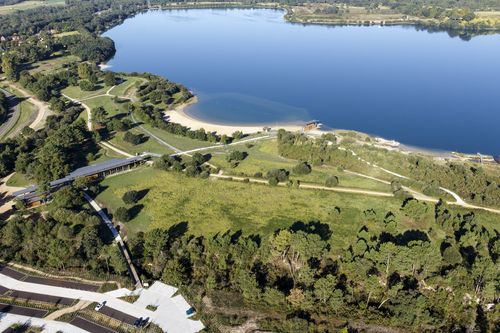
Every morning, the cranes leave the site to join the corn fields, and, at the end of the day, they return to the site and its dormitories. The spectacle is magic when you are in the middle of them. Christian savors his chance like a privileged teenager.
He lives us all the secrets of this migratory bird. The grey cranes are more and more numerous by wintering here thus avoiding the crossing of the Pyrenees.
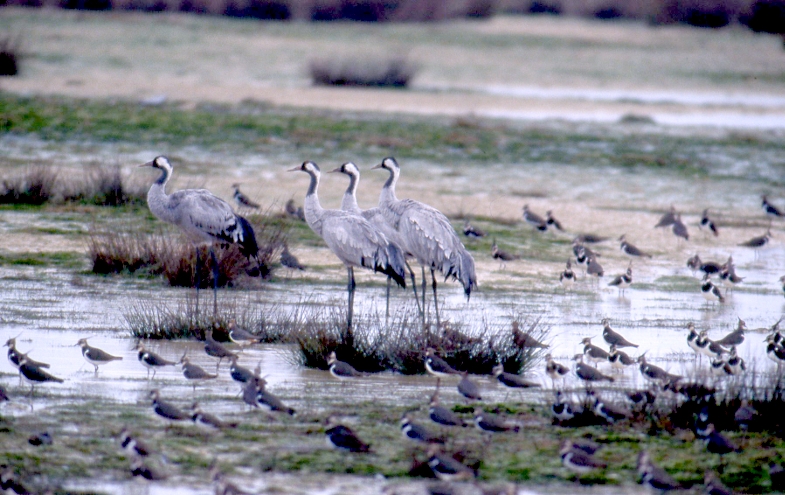
It is one of the largest protected birds in Europe. An American scientist explains the flight: the flight in V, or in formation, answering to a strategy of energy saving, but also to a concern of safety. These flights can group from 20 to 200 individuals. Christian talking to his cranes, imitates the cry of the sandhill crane which is a piercing and nasal “krooh” carrying far (up to 4 km). What a racket then in the Landes sky!
Christian makes us discover the Reproduction: in the zones of nesting of the north of Europe. The couples are united for life. The female lays, generally two eggs, in a nest on the ground and surrounded by water.
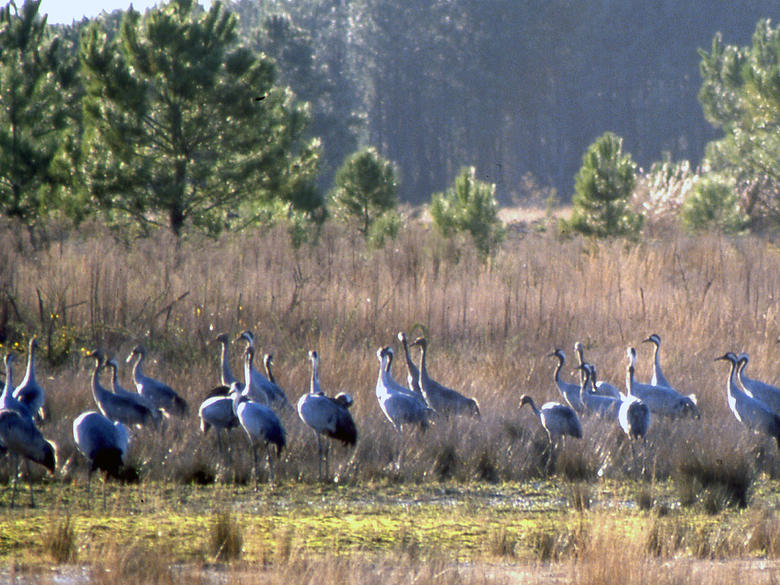
With him we follow the migration of the cranes day by day, step by step, flying among them. The Landes de Gascogne have become a major wintering area for the Gray Cranes for a few years. Cranes are a migratory species that crosses France diagonally in autumn to reach the Spanish lands to spend the winter.
This is a staging area in this migration. The plantations of pines at the expense of the moor in the middle of the 19th century have largely reduced the reception areas for the cranes, which continued their journey to Spain.
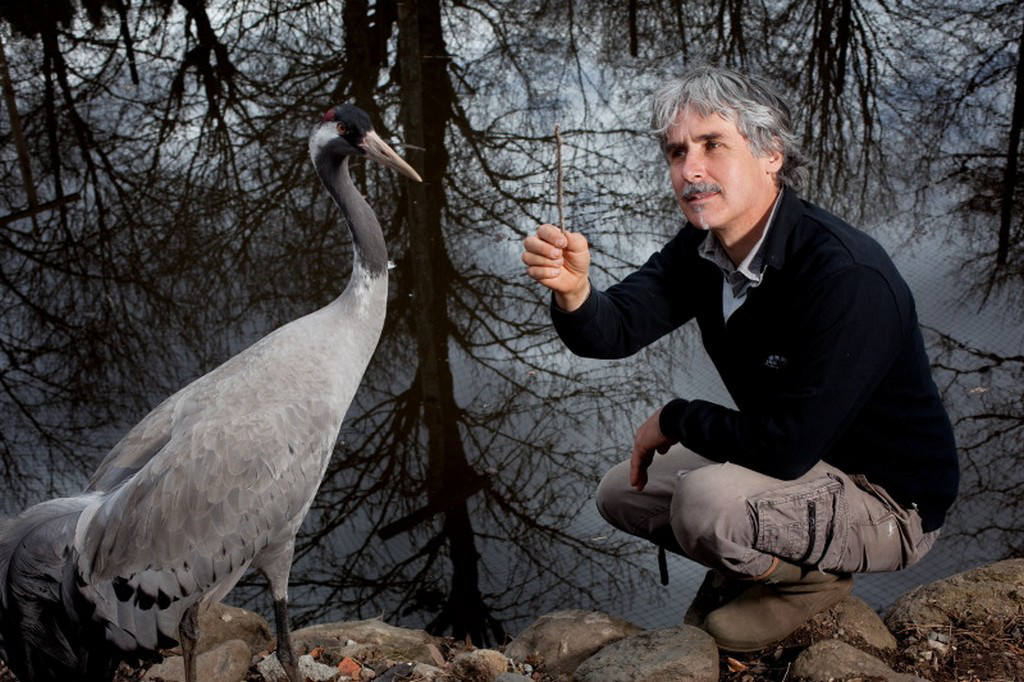
During the winter, 63 000 cranes stay here. The conservation stakes are therefore high, given that ¼ of Western European cranes winter in Landes de Gascogne, while ¾ transit.
Christian takes us on a targeted aerial photographic outing, with the American scientist on board performing geolocation measurements.
Christian makes us discover the Crane Festival which takes place in November: numerous events such as conferences, photo exhibitions, animations, outings…

Several thousands of birds, mostly from Scandinavia, spend the winter here. Christian makes us fly and discover incredible species.
They find in this region the favorable conditions for their residence: refuges for the night and food gleaned from the fields.

Christian follows the ornithologists of the Nature Park, the Maison de la nature du Teich, the LPO and the Arjuzanx reserve, who are experienced professionals.
They offer us a sensitive discovery of the bird with experiments conducted in the field.
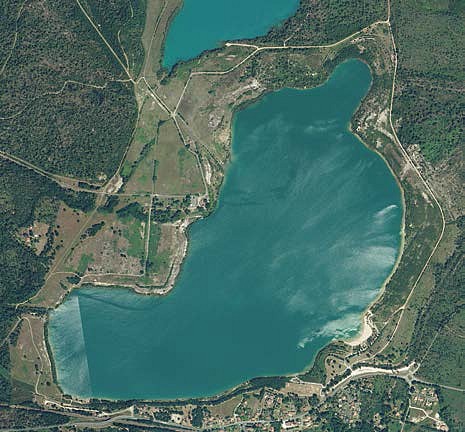
The wintering of the grey crane corresponds to a collective project:
– An ecotourism project
– A project of ecotourism
– The wintering of the grey crane
– A brand for the benefit of sustainable development
– Tourism strategy 2016 2020
It is an emblematic species and the largest European migratory bird.

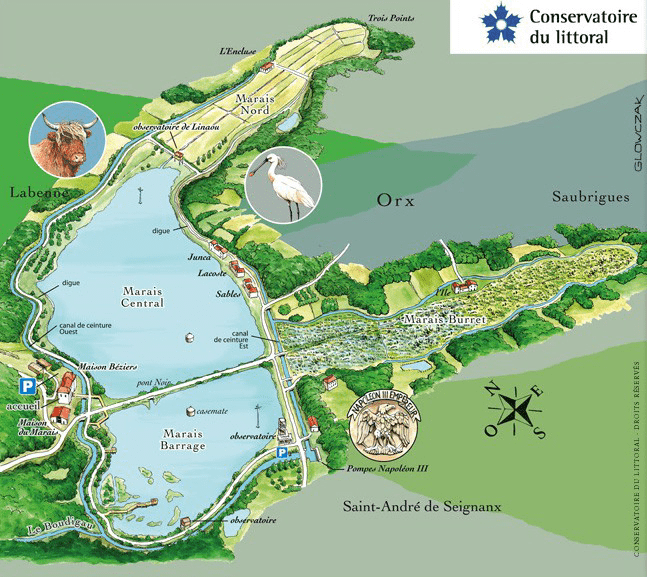
THE SWAMP OF ORX
In the Swamp of Orx. Christian intervenes with his birds in this preserved aquatic nature. The Swamp of Orx is the last large protected wetland of the Aquitaine coast. In view of its strong ornithological interest, this vast property of the Conservatoire du Littoral of nearly 1000 ha (1989), is classified as a National Nature Reserve.
Drained under Napoleon III for agricultural purposes, this former polder surrounded by canals, is now a privileged stopover for migratory birds that find rest and food. Composed of a mosaic of environments (bodies of water, willows, reedbeds, meadows, rushes), the Swamp of Orx welcomes in particular a small special tortoise!
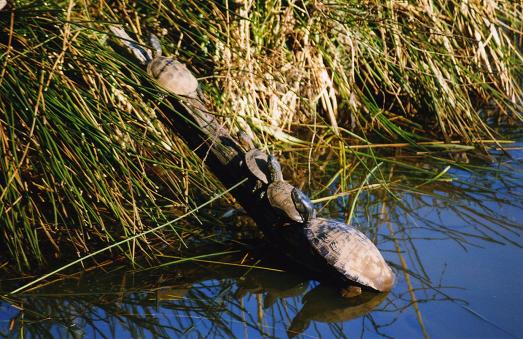
Christian observes a small freshwater turtle unknown to most people: the European pond turtle, also called the muddy turtle. A native aquatic reptile, the European pond turtle is strictly protected. This species is in strong regression, because of the disappearance or the degradation of its habitat: the wetlands. It has a strong interest in terms of conservation issues. Indeed, the preservation of its habitats – wetlands – allowing it to ensure its life cycle, also allows the preservation of a wide range of flora and fauna.

The rehabilitation of the former agricultural domain of the Marais d’Orx has resulted in a vast protected area with a complex hydraulic network, constituting a diversity of environments.
In order to make the public, young and old, aware of the preservation of this flagship species, Christian Moullec proposes to reveal all the secrets of the Cistude.
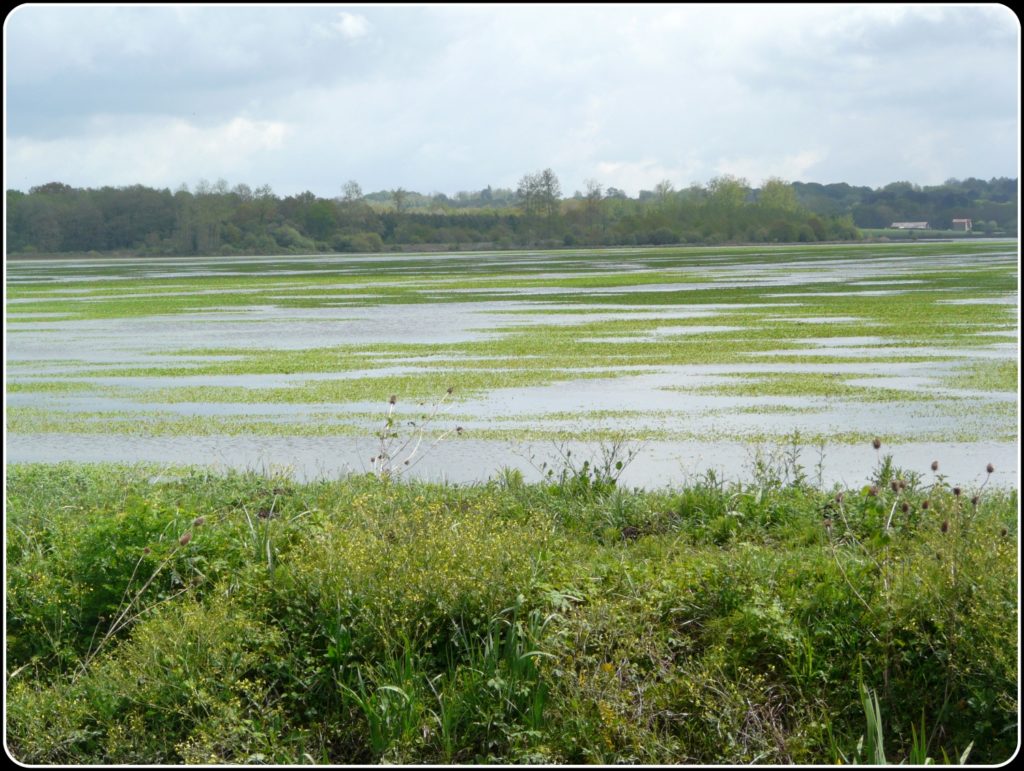
The various wooden structures allow visitors to observe the species without disturbing them, provided they are discreet: the Feathers observatory, the Cistudes palisade, the Legs observatory at the end of a 300-meter long platform in the marsh, the Artists’ Gallery and Workshop, the Invasive Species palisade, the Beaks observatory, the original Marsh platform and the historical pumps sector. Various ornithologists conduct scientific work here.
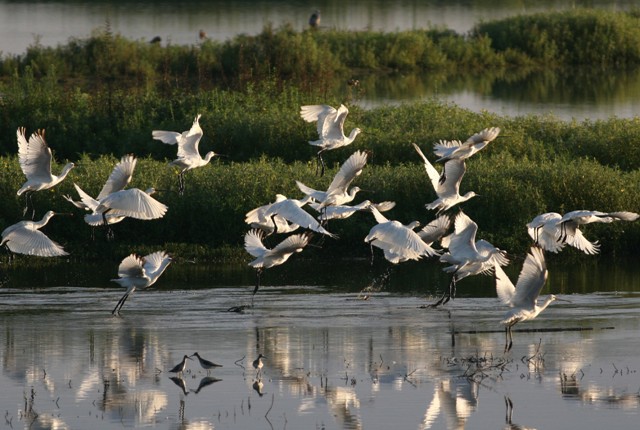
In France, Christian Moullec does not necessarily have a good press among patent ornithologists. His main defect, in their eyes, is to be an autodidact. He is not part of the seraglio. Officially, they believe that his project is too interventionist and that if the species is to disappear from the face of the earth, they can do nothing for it.
Even if the causes of its extinction are not natural. The publicity around Christian’s work also upsets the researchers, who are used to working in the shadows and spend most of their time chasing budgets to continue their work.
Nevertheless, he collaborates with intelligent ornithologists who take advantage of his flights to make scientific studies.

At the same time, he has brought many hunters into birding. “I’ve seen some of them cry when watching my films and hang up their guns”, he confides to us. The man who speaks in the ears of geese also knows, through the sincerity of his commitment, how to speak to the hearts of men.
Christian Moullec flies over the Camargue, with its greylag geese, above herds of horses. Wild manades which, from his point of view, reveal an exceptional vision. Then he lands in the middle of several tens of thousands of ducks (mainly teal, mallards, pintails and shovelers but also kites and scaups) come to spend the winter in the Camargue.
They are especially fond of the Vaccarès pond, which provides them with an exceptional resting area, with 6,300 ha and a nature reserve status. The shoreline is particularly favorable in winter for the observation of ducks.
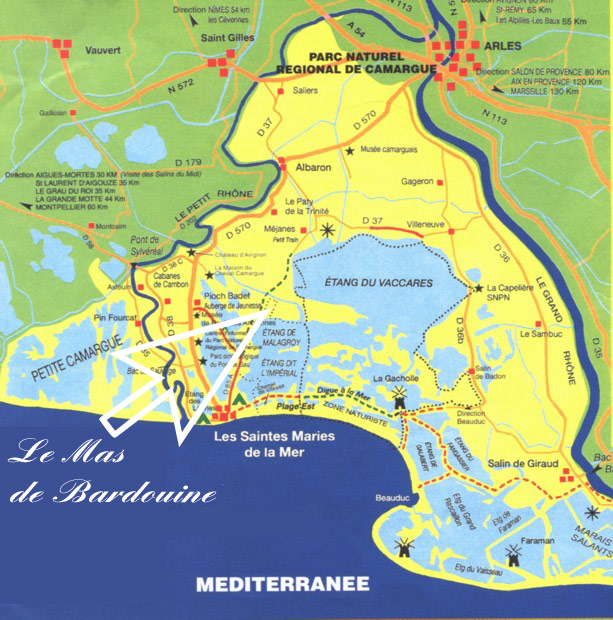
Christian is preoccupied by the greylag geese, immersed with his birds, in their site, in the Camargue. Later, they will cross the Pyrenees to join the Guadalquivir in Spain.
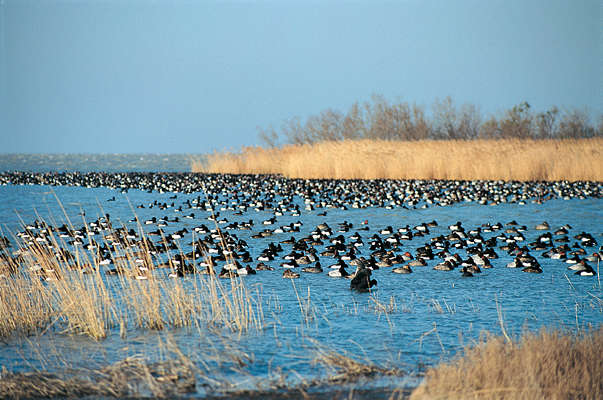
In this extraordinary site of the Camargue, he meets the partners of nature protection. From the month of August the great maneuvers of the migration start: swifts, and black kites open the ball, soon followed by the bondrées then the white storks and all the cohort of the travelers to the long course.
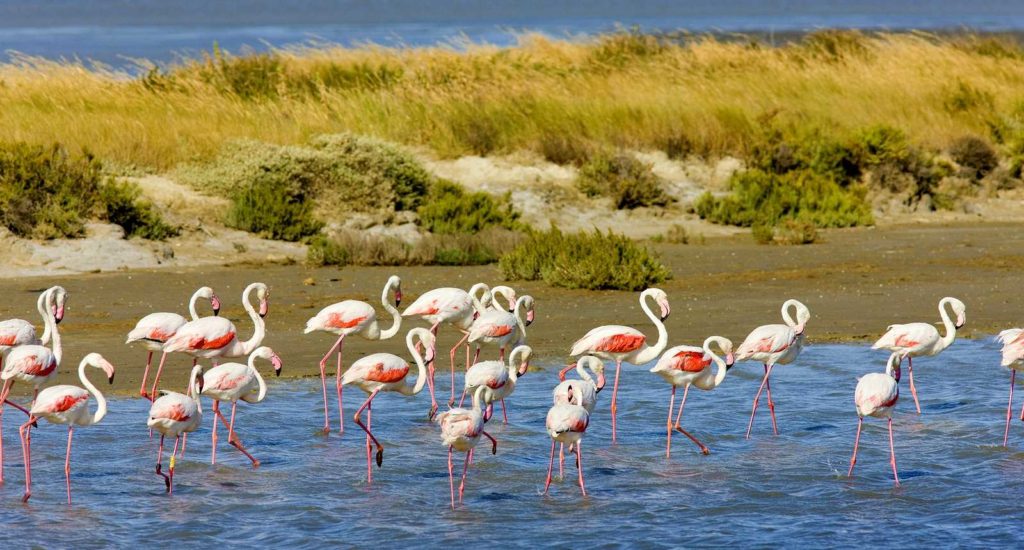
Many go to Africa but others will limit themselves to a European route, leaving hostile lands in winter to land here and there in the more welcoming southern Europe: the Grey Cranes (Grus grus) and Greylag Geese (Anser anser) are a good example.
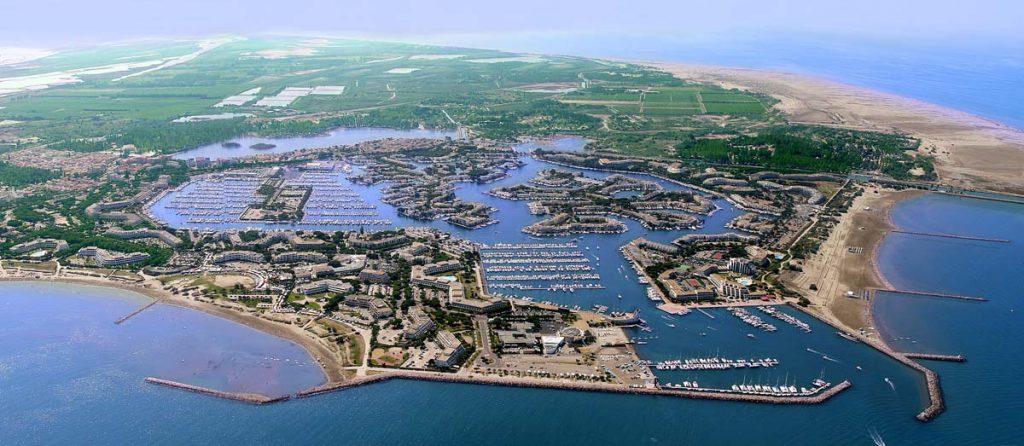
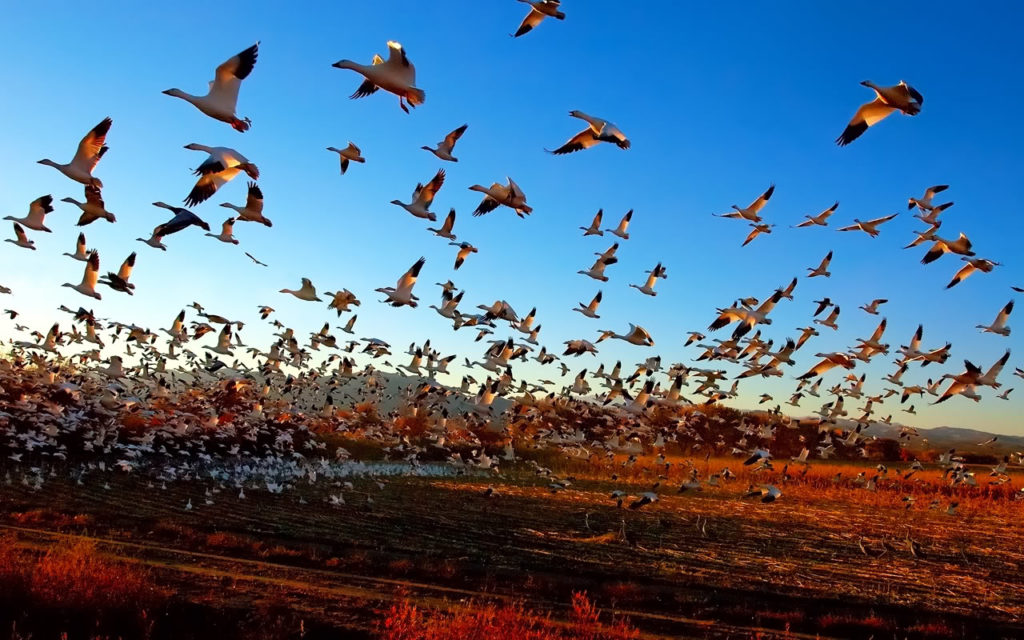
The shortening of the daytime stimulates the migratory instinct and the gatherings are organized, the large troops wait for the signal of the great voyage and it is the weather conditions of the moment which order: clear weather as a consequence of a high pressure centered on Northern Europe… which does not prejudge in any way the weather that will be done further and later.
The greylag geese go north from the end of January until mid-March. Post-breeding passage occurs from September to mid-December, usually in two waves (2nd half of October and mid-November). The Greylag Goose is the ancestor of most domestic geese. It is also the largest of the gray geese.
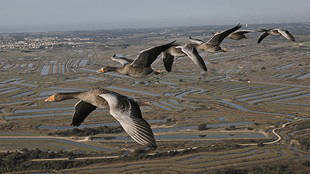
SCREAMS AND SONGS
Christian, on the lookout, observes the Greylag Goose; when he takes off with it, it emits cries in flight, a series of sounding notes resembling horn blasts, and deep, repeated “aahng-ahng-ung.” When they are in groups, the noise is audible from a distance.
This goose produces deeper, more metallic sounds than other breeds of gray geese. Christian in flight among them catches the drone!
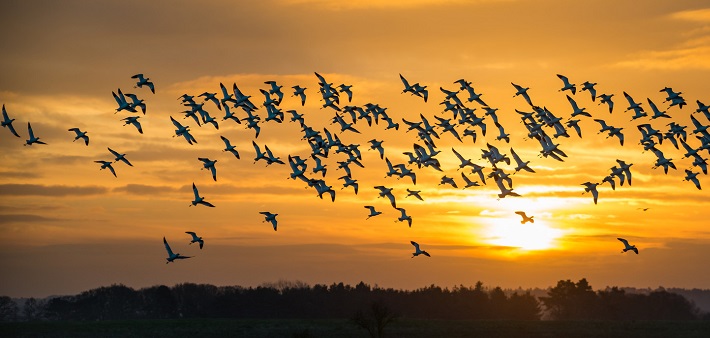
HOUSING
Christian follows the Greylag Goose which frequents wetlands with open land, near meadows or with vegetation borders.
During the winter, this species is found in marshes and cultivated areas in the open countryside, and also on lakes and lagoons.
It moves with a pair of Greylag Geese that usually remains together for life, but the territory is not maintained all year. Most juveniles stay with the adults until the following spring.
The young often spend the summer of their second year on their natal territory, and may help defend and raise the year’s chicks.
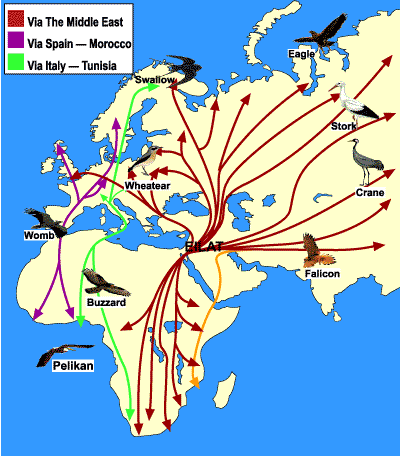
FLIGHT
It is in flight that Christian is happiest. A scientist accompanies him to study their legs which become hotter. They want to solve this mystery!
The Greylag Goose needs to run on the surface of the water to be able to fly with its heavy and stocky body. But it flies very well thanks to its powerful wings. It performs rapid and continuous flapping to maintain its direct flight. When flying in formation, the oldest bird leads the group.
The Greylag Goose is not currently a threatened species. However, drainage of wetlands and hunting pressure have caused several declines. In addition, these geese damage crops, causing conflicts with farmers.
Greylag geese are aquatic species that swim more often than other geese. On land, they walk with less waddling than ducks and are able to run with speed.
During migrations, flocks of geese usually fly in a V formation. The flight is powerful, fast, steady, with fairly slow wingbeats. This species glides before landing and, at the end, falls sharply.
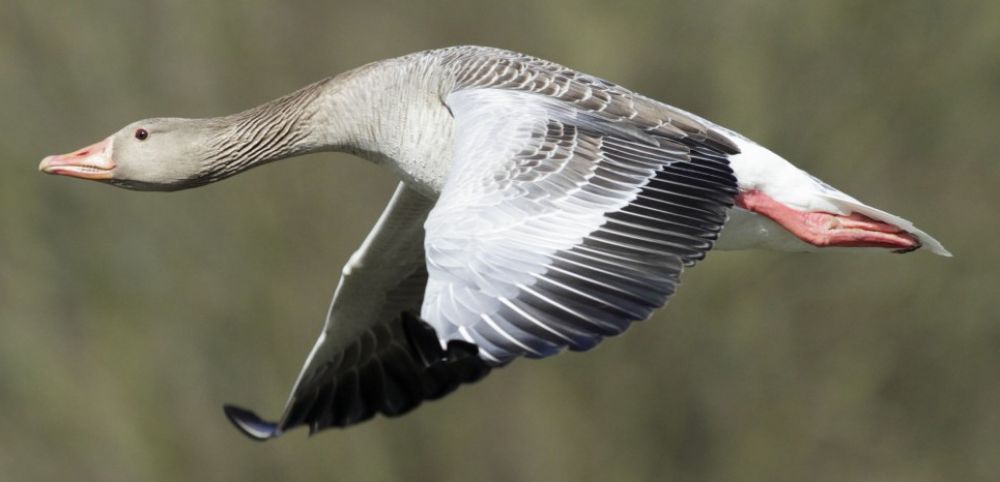
Christian Moullec is concerned about the threats faced by some Greylag Geese.
The main predators of the Greylag Goose are birds of prey, Corvids, stray dogs, foxes… and man.
In addition to direct predation, the latter threatens the geese by destroying their habitat, for example by draining wetlands or by expanding urbanization, and by industrial and agricultural pollution. Any disturbance of wetlands, such as their frequentation by tourists, weakens its populations.

In several European countries, flocks of migrating geese regularly plunder potato or carrot fields. Although regulated in most countries, the hunting of this bird is not only motivated by the consumption of the animal, but also by a feeling of revenge towards the devastating bird.
The greylag goose is the most hunted goose in France. It is also one of the most sensitive geese to lead poisoning by ingestion of lead shot. Even if these toxic pellets are forbidden for waterfowl, the pollution of wetlands is often chronic.
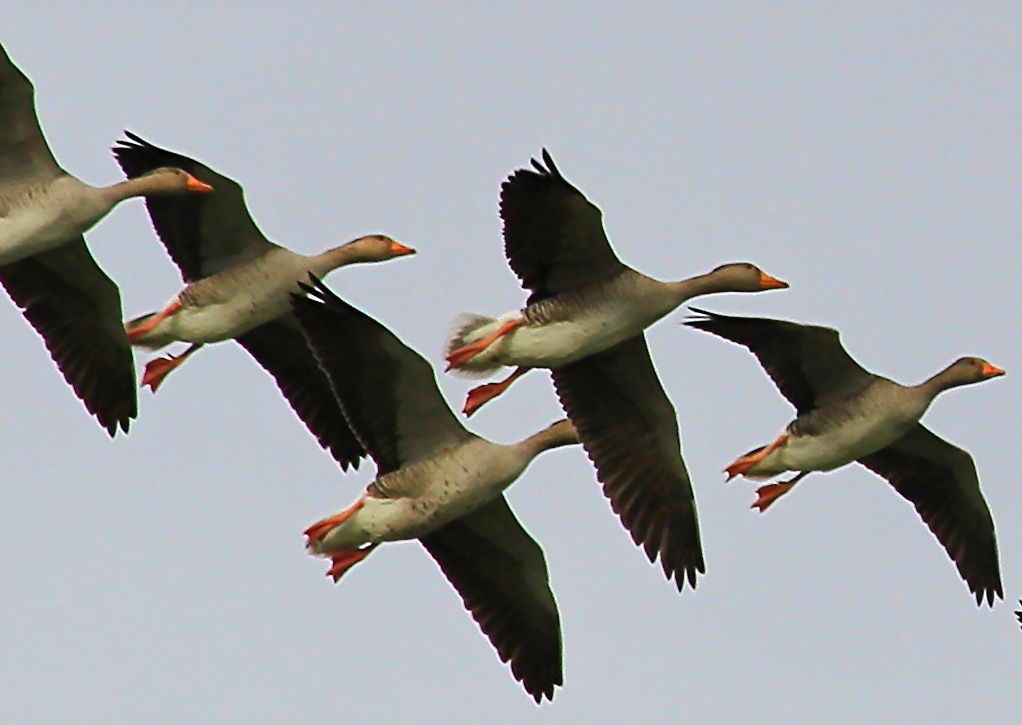
Christian is in a wild bird paradise where he goes all out in his observations and interactions with birds. His floating Ulm is his base. The Camargue is a 150,000 hectare paralic wetland that is home to many animal and plant species. It is classified as a biosphere reserve and regional nature park.
Since the 19th century, it has been the subject of water control operations. The Camargue shelters an exceptional living heritage. It is a migratory stopover for ducks and waterfowl: 150 000 individuals are counted in transit each year. Many ducks winter in the Vaccarès pond.

In summer, there are up to 30,000 pink flamingos: Christian flies with the flamingos. The Camargue is the only annual place of reproduction in Europe for this animal. An island has been set up for its reproduction on the Fangassier pond that Christian discovers with excitement.
The Camargue is home to the coypu, introduced in the 19th century. The Camargue is also known for its mosquitoes: there are 40 species. And with them, Paradise sometimes has a taste of hell! Christian suffers from it!
The particular climate and environment see the development of adapted plants, such as salicornia and saladelles, which have the particularity of growing in a salty environment, as well as the sand lily which blooms in the dunes.


The natural heritage of the Camargue is subject to several constraints that put it in danger, such as the pollution caused by the Rhone, the retreat of natural areas for the benefit of agriculture, hunting or the sea that erodes the beaches of the coast.

At the same time as he discovers all these beauties Christian discovers a threatened heritage! The biological wealth of the Rhone delta is recognized worldwide. They make the region a true “natural monument”.
In order to ensure the conservation of this exceptional heritage, it has been necessary to remove huge areas from multiple pressures, agricultural, industrial, urban, tourist.
The protective associations testify to this in Christian. Today, the protected natural spaces cover 25,000 ha of the delta, i.e. about 20% of its surface. In addition, management policies favorable to the conservation of nature (extensive grazing, reasoned agriculture) have multiplied, particularly within the framework of the actions of the Regional Natural Park.
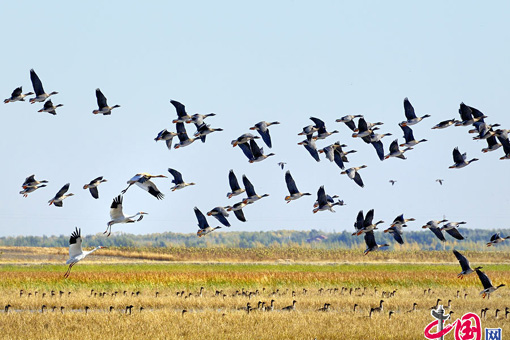
With its birds in flight, Christian discovers that it has environments (salt steppes, lagoons, marshes…) rarely found elsewhere on such an expanse, thus playing a role of refuge for many rare species of plants and animals. Placed on the path of the great North/South migrations, it constitutes a feeding and resting place for countless birds.
The delta is therefore an extremely popular stopover. Little exposed to freezing waters, it is also very attractive in winter especially for water birds (about 150,000 ducks each winter). The greylag goose is one of the 11 species present in the Camargue which are registered in the red list as “vulnerable”.
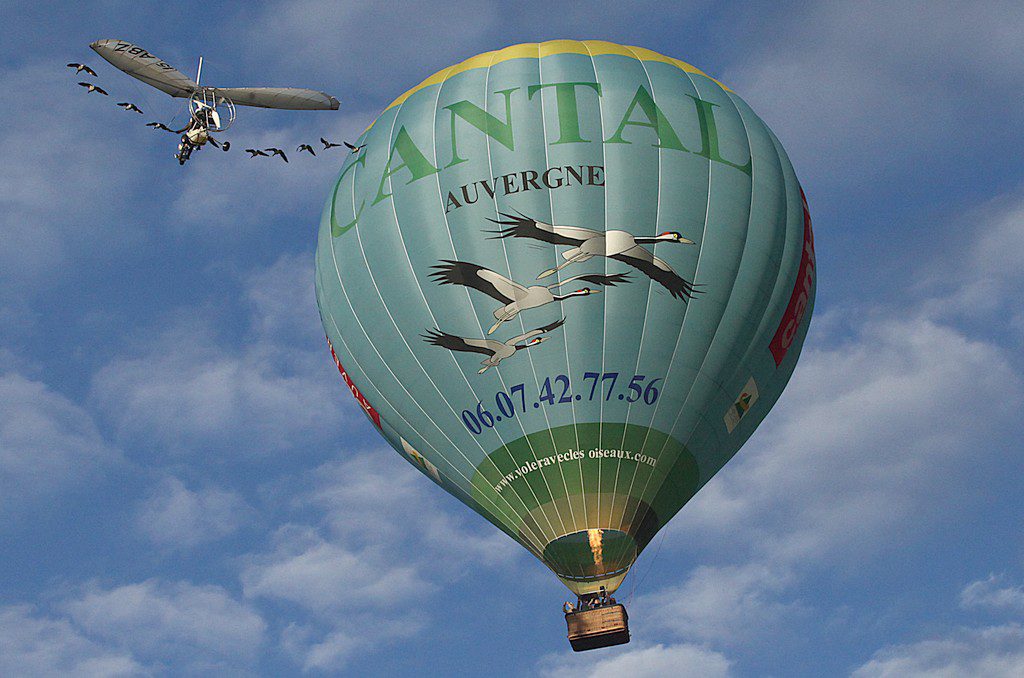
The Camargue is home to the largest number of wintering animals in France. But will this last? Because of this great diversity of water birds, the Camargue has become a site of community importance for the wintering of anatidae. We also observe a large number of species associated with wetlands (amphibians, reptiles, insects, mammals …).